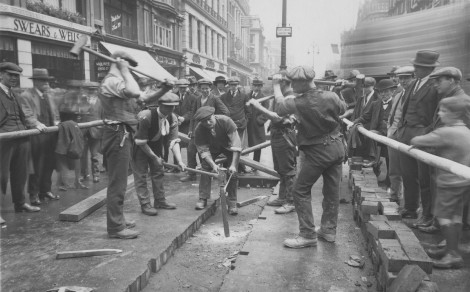Making the wheels go around

Moving from water to steam power
Although water power continued to be an essential energy source, the invention of the steam engine was the inspiration, the outstanding source of power and the major workhorse for industry, and eventually transport systems, throughout the Western world for almost 200 years.
However, working conditions were dangerous, dirty and dark. Coal-fired steam-raising meant workers emerged after long hours coated with soot and suffering from eye problems and lung diseases. The pioneering work of Newcomen and Watt with steam technology in the mid-1700s prepared the way for the development of sophisticated heat engines, innovations that in the early 20th century expedited the large-scale generation of electricity, which ultimately replaced steam.
Clean power arrives
Ironically, a coal-powered steam engine attached to the world’s first electric generator at Thomas Edison’s plant in New York City provided the first electric light in 1880. Five years later an Italian named Galileo Ferraris produced the first two-phase electric induction motor. However, it was the chief electrician at the AEG company in Berlin who developed the ideas of both Nikola Tesla and Ferraris, with designs for a three-phase cage induction motor, still used today.
Shortly afterwards, a British patent was filed by Swedish engineer and inventor Jonas Wenström for the components of a three-phase electrical power system. In 1890 he built a three-phase generator that became the heart of the first AC power transmission system installed in Sweden.
Large-scale electrification of factories began around 1900 after the development of the AC motor. At first, large motors were added to workshop line shafts, but as soon as small-horsepower motors became widely available, factories switched to workplace unit drives. Eliminating line shafts freed factories from layout constraints and they became more efficient − in much the same way as many of today’s workplace stationary air compressors, sited at the point of use rather than in a remote compressor house.
Compressed air comes of age
With the Industrial Revolution, the mechanical air compressor was born, inspired by John Wilkinson’s hydraulic blowing machine. Far from just heating blacksmiths’ fires, the air compressor was now in use in metal mines, fabrication plants and in underground work areas where ventilation was needed.
The idea of using compressed air to transmit energy became popular around 1800 as metal manufacturing plants grew. Unlike steam, compressed air could be piped over long distances without incurring pressure losses due to condensation.
An early application was in the drilling of the eight-mile-long Mont Cenis rail tunnel in Switzerland in 1861, where compressed air plant powered pneumatic rock drills. It was an innovation that resulted in increased productivity over previous manual drilling methods. Furthermore, it contributed to the safety of the workforce by eliminating hazardous steam-driven tools and drills.
By 1891 Europe’s first dedicated compressed air plant in Paris was producing the equivalent of 18,000 kW across the city. Although it never outperformed electricity, the concept did spark interest in compressed air’s potential for production processes. Soon, inventors were moving in to patent a variety of tools that ran on compressed air.
-
PPMA 2025
23 September, 2025, 9:30 - 25 September, 2025, 16:00
NEC, Birmingham UK -
Advanced Engineering Show 2025
29 October, 2025, 9:00 - 30 October, 2025, 16:00
NEC, Birmingham UK










